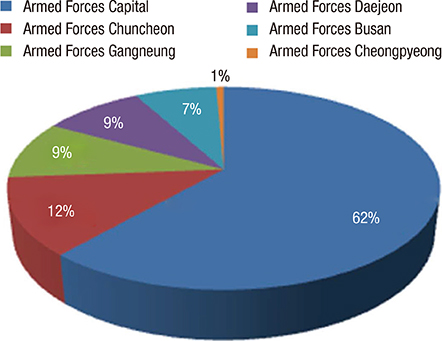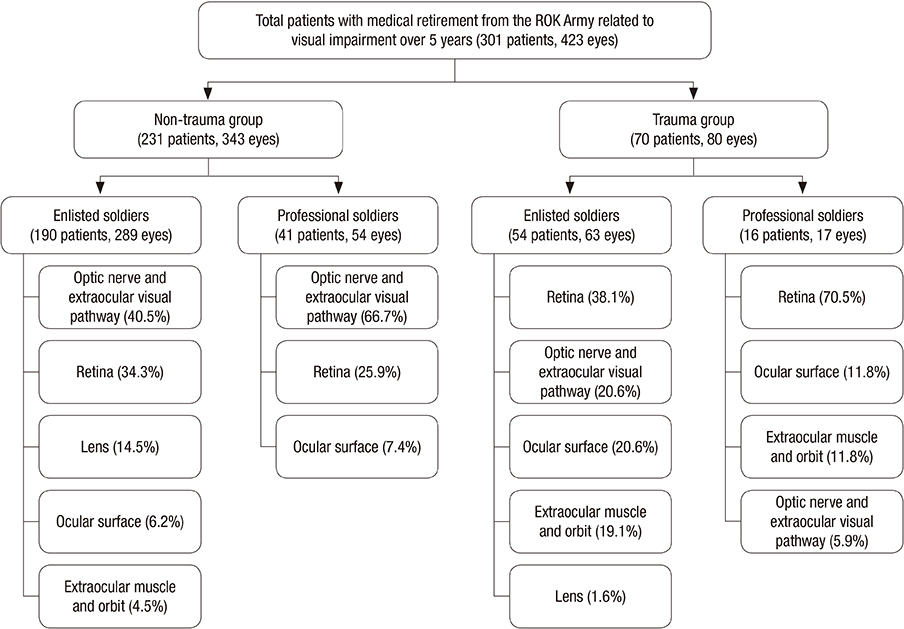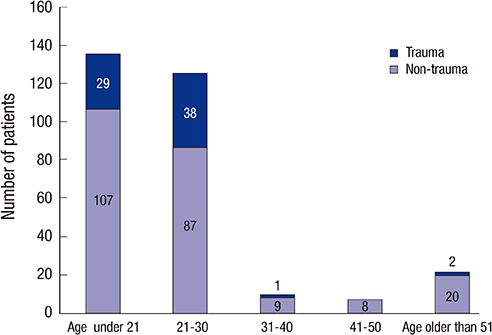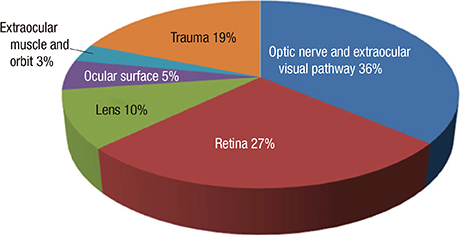J Korean Med Sci.
2016 Apr;31(4):623-629. 10.3346/jkms.2016.31.4.623.
Epidemiologic Aspects of Medical Retirement from the Republic of Korea Army due to Visual Impairment
- Affiliations
-
- 1Chung-Ang University Graduate School, Seoul, Korea.
- 2Department of Ophthalmology, Konyang University College of Medicine, Daejeon, Korea.
- 3Department of Ophthalmology, Chung-Ang University College of Medicine, Seoul, Korea. yschun100@hanmail.net
- 4Department of Ophthalmology, Seoul National University College of Medicine, Seoul, Korea.
- KMID: 2363704
- DOI: http://doi.org/10.3346/jkms.2016.31.4.623
Abstract
- This study was done to report the epidemiologic characteristics of medical retirement from the Republic of Korea (ROK) Army due to visual impairment and to suggest a practical screening system for the draft. The medical records of 423 eyes of 301 patients who retired from the ROK Army due to visual impairment were reviewed retrospectively between January 2010 and December 2014. The patients were grouped by the presence of trauma, and each group was subdivided by military rank. We analyzed demographic and ophthalmic data, including the etiology of ophthalmologic disease. The etiology was classified into 5 anatomical categories (ocular surface, lens, retina, optic nerve and extraocular visual pathway, and extraocular muscle and orbit), which were then subdivided into the type of disease. The mean age was 24.5 years, and non-traumatic mechanisms accounted for 81.1% (343/423 eyes) of medical retirements. Visual acuity was better in patients without trauma. In enlisted soldiers, disease in the optic nerve and extraocular visual pathway was the most common anatomical category (40.5%), and primary open angle glaucoma (30.8%), retinal dystrophy (18.3%), congenital cataract (14.5%), and retinal detachment (9.7%) were the four most common diseases. Most medical retirements due to visual impairment resulted from non-traumatic mechanisms, even though patients were young. The fundus examination and visual field test would be more useful tools than a conventional vision test for large-scale draft screening for the most common two disease types: primary open angle glaucoma and retinal dystrophy.
Keyword
MeSH Terms
Figure
Reference
-
1. Ministry of National Defense (KR). Annual report of statistics on national defense 2014 [Internet]. Seoul: Ministry of National Defense;2014. accessed on 20 October 2015. Available at http://www.mnd.go.kr/user/boardList.action?command=view&page=1&boardId=O_46843&boardSeq=I_1843607&titleId=null&siteId=mnd&id=mnd_050300000000.2. Lee KH, Lee WH, Jeong JH, Park YM. The Statistical observation of ocular injury in the military. J Korean Ophthalmol Soc. 2013; 54:1416–1422.3. Bauza AM, Emami P, Soni N, Holland BK, Langer P, Zarbin M, Bhagat N. A 10-year review of assault-related open-globe injuries at an urban hospital. Graefes Arch Clin Exp Ophthalmol. 2013; 251:653–659.4. Schmidt GW, Broman AT, Hindman HB, Grant MP. Vision survival after open globe injury predicted by classification and regression tree analysis. Ophthalmology. 2008; 115:202–209.5. Kim CS, Seong GJ, Lee NH, Song KC; Namil Study Group, Korean Glaucoma Society. Prevalence of primary open-angle glaucoma in central South Korea the Namil study. Ophthalmology. 2011; 118:1024–1030.6. Arkell SM, Lightman DA, Sommer A, Taylor HR, Korshin OM, Tielsch JM. The prevalence of glaucoma among Eskimos of northwest Alaska. Arch Ophthalmol. 1987; 105:482–485.7. Dandona L, Dandona R, Srinivas M, Mandal P, John RK, McCarty CA, Rao GN. Open-angle glaucoma in an urban population in southern India: the Andhra Pradesh eye disease study. Ophthalmology. 2000; 107:1702–1709.8. Foster PJ, Baasanhu J, Alsbirk PH, Munkhbayar D, Uranchimeg D, Johnson GJ. Glaucoma in Mongolia. A population-based survey in Hövsgöl province, northern Mongolia. Arch Ophthalmol. 1996; 114:1235–1241.9. Foster PJ, Oen FT, Machin D, Ng TP, Devereux JG, Johnson GJ, Khaw PT, Seah SK. The prevalence of glaucoma in Chinese residents of Singapore: a cross-sectional population survey of the Tanjong Pagar district. Arch Ophthalmol. 2000; 118:1105–1111.10. Klein BE, Klein R, Sponsel WE, Franke T, Cantor LB, Martone J, Menage MJ. Prevalence of glaucoma. The Beaver Dam Eye Study. Ophthalmology. 1992; 99:1499–1504.11. Leske MC, Connell AM, Schachat AP, Hyman L. The Barbados Eye Study. Prevalence of open angle glaucoma. Arch Ophthalmol. 1994; 112:821–829.12. Mitchell P, Smith W, Attebo K, Healey PR. Prevalence of open-angle glaucoma in Australia. The Blue Mountains Eye Study. Ophthalmology. 1996; 103:1661–1669.13. Quigley HA, West SK, Rodriguez J, Munoz B, Klein R, Snyder R. The prevalence of glaucoma in a population-based study of Hispanic subjects: Proyecto VER. Arch Ophthalmol. 2001; 119:1819–1826.14. Shiose Y, Kitazawa Y, Tsukahara S, Akamatsu T, Mizokami K, Futa R, Katsushima H, Kosaki H. Epidemiology of glaucoma in Japan--a nationwide glaucoma survey. Jpn J Ophthalmol. 1991; 35:133–155.15. Tielsch JM, Katz J, Singh K, Quigley HA, Gottsch JD, Javitt J, Sommer A. A population-based evaluation of glaucoma screening: the Baltimore Eye Survey. Am J Epidemiol. 1991; 134:1102–1110.16. Wensor MD, McCarty CA, Stanislavsky YL, Livingston PM, Taylor HR. The prevalence of glaucoma in the Melbourne Visual Impairment Project. Ophthalmology. 1998; 105:733–739.17. Turalba AV, Chen TC. Clinical and genetic characteristics of primary juvenile-onset open-angle glaucoma (JOAG). Semin Ophthalmol. 2008; 23:19–25.18. Molteno AC, Ancker E, Van Biljon G. Surgical technique for advanced juvenile glaucoma. Arch Ophthalmol. 1984; 102:51–57.19. Ministry of National Defense (KR). 2014 Defense white paper [Internet]. Seoul: Ministry of National Defense;2014. accessed on 20 October 2015. Available at http://www.mnd.go.kr/cop/pblictn/selectPublicationUser.do?siteId=mnd&componentId=14&categoryId=15&publicationSeq=672&pageIndex=1&id=mnd_050601000000.
- Full Text Links
- Actions
-
Cited
- CITED
-
- Close
- Share
- Similar articles
-
- Impact of Retirement Expectation and Retirement Readiness on Retirement Anxiety among Middle-aged Nurses
- Lack of Retirement Preparation is Associated with Increased Depressive Symptoms in the Elderly: Findings from the Korean Retirement and Income Panel Study
- Influence of Sensory Impairments on Incidence of Dementia in the Korean Population
- The Influence of Care Stress for Older Patients, Self-perceptions of Aging, Aging Anxiety on Retirement Preparation in Nurses
- Dedication: The Korean Society of Pediatric Gastroenterology, Hepatology and Nutrition Celebrates the Retirement of Professor Jeong Kee Seo





